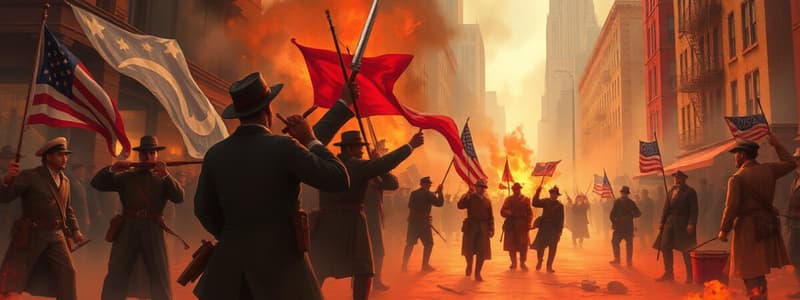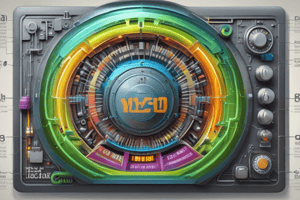Podcast
Questions and Answers
What factor most directly contributed to the New York City Draft Riots?
What factor most directly contributed to the New York City Draft Riots?
- Widespread opposition to the newly implemented conscription policies. (correct)
- The Union army's victory at the Battle of Gettysburg.
- The Democratic Party's loss of control over the city's political wards.
- A lack of municipal services available to the city's poor.
Which group was NOT a primary target of violence during the New York City Draft Riots?
Which group was NOT a primary target of violence during the New York City Draft Riots?
- African Americans
- Confederate sympathizers. (correct)
- Policemen
- Army officers
What was the Democratic Party's main strategy to secure votes in New York City during the period leading up to the draft?
What was the Democratic Party's main strategy to secure votes in New York City during the period leading up to the draft?
- Investing heavily in public education and infrastructure.
- Enforcing strict segregation laws to maintain social order.
- Providing direct financial aid to impoverished families.
- Expediting the citizenship process for immigrants. (correct)
How did the Emancipation Proclamation indirectly contribute to the tensions leading to the New York City Draft Riots?
How did the Emancipation Proclamation indirectly contribute to the tensions leading to the New York City Draft Riots?
Why were immigrants who had applied for citizenship made eligible for conscription?
Why were immigrants who had applied for citizenship made eligible for conscription?
What action did the mob from the New York City Draft Riots NOT take?
What action did the mob from the New York City Draft Riots NOT take?
What primary economic factor motivated increased immigration during the Civil War despite its disruption?
What primary economic factor motivated increased immigration during the Civil War despite its disruption?
Which statement accurately describes the social climate in New York City leading up to the Draft Riots?
Which statement accurately describes the social climate in New York City leading up to the Draft Riots?
What was the immediate trigger that sparked the New York City Draft Riots on July 13, 1863?
What was the immediate trigger that sparked the New York City Draft Riots on July 13, 1863?
Why did some immigrants view military service during the Civil War as a potential benefit?
Why did some immigrants view military service during the Civil War as a potential benefit?
What was a common experience for some newly arrived immigrants regarding military service?
What was a common experience for some newly arrived immigrants regarding military service?
What was a significant challenge faced specifically by Irish immigrants in the Northern states during the Civil War era?
What was a significant challenge faced specifically by Irish immigrants in the Northern states during the Civil War era?
What is the historical significance of the 'Irish Brigade' during the Civil War?
What is the historical significance of the 'Irish Brigade' during the Civil War?
How did the Democratic Party attempt to mobilize opposition against the draft during the Civil War?
How did the Democratic Party attempt to mobilize opposition against the draft during the Civil War?
What potential outcome did New York Governor Horatio Seymour predict as a result of implementing the draft?
What potential outcome did New York Governor Horatio Seymour predict as a result of implementing the draft?
What role did a New York City Catholic newspaper play in the resistance of the draft?
What role did a New York City Catholic newspaper play in the resistance of the draft?
What was the initial reason for the Northern states' enthusiasm for enlisting in the Civil War?
What was the initial reason for the Northern states' enthusiasm for enlisting in the Civil War?
What impact did Lincoln's Preliminary Emancipation Proclamation have on recruitment efforts in the North?
What impact did Lincoln's Preliminary Emancipation Proclamation have on recruitment efforts in the North?
How did the U.S. government respond to resistance against conscription during the Civil War?
How did the U.S. government respond to resistance against conscription during the Civil War?
What was the primary reason for the introduction of conscription by both the Union and the Confederacy during the Civil War?
What was the primary reason for the introduction of conscription by both the Union and the Confederacy during the Civil War?
What was the significance of the Democrats' opposition to the draft and emancipation in the 1862 election?
What was the significance of the Democrats' opposition to the draft and emancipation in the 1862 election?
Which of the following factors contributed to growing opposition to the draft in the North?
Which of the following factors contributed to growing opposition to the draft in the North?
What action did Congress take in July 1862 regarding military recruitment?
What action did Congress take in July 1862 regarding military recruitment?
What does the political cartoon depicting a soldier with a bayonet at a civilian's throat, standing next to a "To the Drafting Office" sign, likely represent?
What does the political cartoon depicting a soldier with a bayonet at a civilian's throat, standing next to a "To the Drafting Office" sign, likely represent?
What was the main argument used by Republicans to denounce those who opposed the Civil War and the government?
What was the main argument used by Republicans to denounce those who opposed the Civil War and the government?
What was the purpose of the Enrollment Act passed by Congress in March 1863?
What was the purpose of the Enrollment Act passed by Congress in March 1863?
What was the implication of the $300 commutation fee within the context of the Civil War draft?
What was the implication of the $300 commutation fee within the context of the Civil War draft?
Besides paying a commutation fee, what other method could a drafted individual use to avoid military service during the Civil War?
Besides paying a commutation fee, what other method could a drafted individual use to avoid military service during the Civil War?
What was the primary role of the provost marshals under the Enrollment Act?
What was the primary role of the provost marshals under the Enrollment Act?
What does the phrase "rich man's war and [a] poor man's fight" refer to, in the context of the Civil War?
What does the phrase "rich man's war and [a] poor man's fight" refer to, in the context of the Civil War?
What was a common response among those drafted into military service who wished to avoid it?
What was a common response among those drafted into military service who wished to avoid it?
Who were some of the individuals that could potentially be substitutes in the Civil War draft?
Who were some of the individuals that could potentially be substitutes in the Civil War draft?
Flashcards
Conscription
Conscription
Forcing individuals to serve in the military.
Conscription during the Civil War
Conscription during the Civil War
Confederacy introduced first, both sides faced opposition.
Militia Law of 1862
Militia Law of 1862
Authorized the president to draft state militia into the national army.
Emancipation Proclamation (Preliminary)
Emancipation Proclamation (Preliminary)
Signup and view all the flashcards
Effect of Emancipation Proclamation
Effect of Emancipation Proclamation
Signup and view all the flashcards
Reasons for opposition to the war
Reasons for opposition to the war
Signup and view all the flashcards
Military response to draft resistance
Military response to draft resistance
Signup and view all the flashcards
Political impact of draft resistance
Political impact of draft resistance
Signup and view all the flashcards
Copperheads
Copperheads
Signup and view all the flashcards
Enrollment Act
Enrollment Act
Signup and view all the flashcards
Provost Marshals
Provost Marshals
Signup and view all the flashcards
Draft Exemptions
Draft Exemptions
Signup and view all the flashcards
Commutation Fee ($300)
Commutation Fee ($300)
Signup and view all the flashcards
Draft Substitute
Draft Substitute
Signup and view all the flashcards
"Rich man's war, poor man's fight"
"Rich man's war, poor man's fight"
Signup and view all the flashcards
Draft Evasion
Draft Evasion
Signup and view all the flashcards
Immigration during the Civil War
Immigration during the Civil War
Signup and view all the flashcards
Immigrants and Military Service
Immigrants and Military Service
Signup and view all the flashcards
Immigrant exploitation
Immigrant exploitation
Signup and view all the flashcards
Nativism during the Civil War
Nativism during the Civil War
Signup and view all the flashcards
The Irish Brigade
The Irish Brigade
Signup and view all the flashcards
Racist rhetoric against the draft
Racist rhetoric against the draft
Signup and view all the flashcards
Iowa Democrats' Stance
Iowa Democrats' Stance
Signup and view all the flashcards
Horatio Seymour
Horatio Seymour
Signup and view all the flashcards
NYC Draft Riots Catalyst
NYC Draft Riots Catalyst
Signup and view all the flashcards
NYC Social Divisions (1863)
NYC Social Divisions (1863)
Signup and view all the flashcards
NYC Immigrant Groups (1863)
NYC Immigrant Groups (1863)
Signup and view all the flashcards
Status of African Americans in NYC (1863)
Status of African Americans in NYC (1863)
Signup and view all the flashcards
Democratic Machine in NYC
Democratic Machine in NYC
Signup and view all the flashcards
Immigrants and the Draft
Immigrants and the Draft
Signup and view all the flashcards
Reasons for Anti-Black Sentiment
Reasons for Anti-Black Sentiment
Signup and view all the flashcards
Troop Deployment & Riots
Troop Deployment & Riots
Signup and view all the flashcards
Study Notes
- During the Civil War, the U.S. government implemented conscription, which raised questions about forcing individuals to fight for others' freedom
Confederacy's Conscription
- The Confederacy initially introduced conscription and faced widespread opposition
- As the war continued and casualties increased, the Union's volunteer numbers decreased, making conscription more relevant
Union's Militia Law
- In July 1862, Congress passed a militia law, allowing the president to draft state militia troops into the national army
- Some states delayed implementation by successfully recruiting volunteers
- By autumn, the government widely used the "state draft" to authorize the president to draft militiamen, especially after Lincoln's Preliminary Emancipation Proclamation
Emancipation Proclamation Impact
- Lincoln's Emancipation Proclamation on January 1, 1863, made the war about slavery, which was unpopular in the North
- Racist sentiment, job competition fears with blacks, higher taxes, and expanded government power added to the opposition
Resistance to Conscription
- Recruitment became difficult, and federal authorities used inducements and conscription threats
- Opponents protested, sometimes violently
- The army used troops in areas of resistance like Pennsylvania coal regions, German Catholic communities in Wisconsin, and parts of Indiana, Illinois, and Ohio
- Provost marshals arrested resisters, and the army imprisoned antiwar activists, leading to more protests
Political Cartoon
- A political cartoon titled "Don't you see the point?" appeared in Harper's Weekly on August 29, 1863
Democrats' Opposition
- In the fall of 1862, Democrats used civil liberties, racism, and opposition to the draft and emancipation to gain ground with voters
- Republicans labeled war opponents as traitors and called some Democrats "Copperheads"
- Republicans maintained their congressional majority, but Democrats gained control in several states, including New York
- The draft became a divisive political policy, unifying the opposition
Enrollment Act of 1863
- In March 1863, Congress passed the Enrollment Act, authorizing a national draft
- All able-bodied male citizens and immigrants between 20 and 45 were to be enrolled
- Provost marshals implemented the draft when districts couldn't meet quotas with volunteers
- The first draft was in July 1863, followed by three more in 1864
Draft Exemptions
- Exemptions were available for those supporting widows, aging parents, or motherless children
- Draftees could hire substitutes or pay a $300 commutation fee
- Substitutes were often young men, and immigrants who hadn't applied for citizenship were substitutes
- The option to hire a substitute or pay a fee angered many, who viewed the conflict as "a rich man's war and a poor man's fight"
- Over 20% of those drafted refused to report, fleeing West or hiding
Immigration Concerns
- Immigration increased before the war, slowed at the start, but grew again due to demand for workers and higher wages
- Some immigrants saw military service as a financial opportunity through enlistment bounties and hiring substitutes
Immigrant Soldiers
- About 25% of Union soldiers were immigrants, some tricked into service
- Nativism was strong, and Irish immigrants faced prejudice and bigotry due to being Roman Catholic
- Immigrant troops served well in ethnic units like the Irish Brigade from New York, which fought at Antietam and Gettysburg
Opposition to the Draft
- Many in the North viewed the draft as a violation of freedom
- The first national draft in July 1863 led to protests and violence
- The Democratic Party used racist rhetoric against freeing black slaves to rally the poor, workers, white farmers, and immigrants against the draft
- Race, ethnicity, economics, and government power expansion contributed to the draft crisis
Iowa Democrats' Opposition
- Iowa Democrats opposed Lincoln's "wicked Abolition crusade" and resisted drafting citizens
- New York's governor, Horatio Seymour, predicted the draft would lead to mob violence
- Protests occurred nationwide, with the worst being the New York City Draft Riots
New York City's Tensions
- New York City was divided along ethnic, racial, social class, and religious lines
- Many German and Irish immigrants lived in ethnic areas and worked for low wages
- African Americans also faced racism and discrimination
- The Democratic Party's political machine organized wards to win elections and moved immigrants to citizenship quickly to get their votes
Draft Lottery in NYC
- On July 11, 1863, army officers began the draft lottery in New York City
- Most Union troops had been sent to help stop the Confederate invasion
- On July 13, a mob formed in opposition to conscription, leading to riots, violence, and property destruction
- Buildings were set on fire, firefighters were attacked, and soldiers, policemen, and African Americans were targeted
- The mob beat, tortured, and lynched black men, setting their bodies afire
Studying That Suits You
Use AI to generate personalized quizzes and flashcards to suit your learning preferences.




